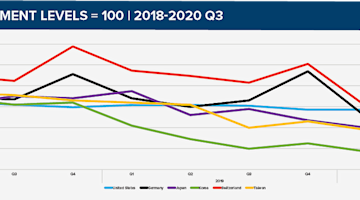USMTO closed a historic year as we published December 2019 data reports. Topping the list was the complete redevelopment of USMTO operating software. From the user interface to the duplicate elimination and masking algorithms, USMTO is a new and improved program.
The redevelopment will save nearly six figures a year in programming and administrative costs while improving the user experience, data quality, and sustainability of the program. The Economics & Statistics (E&S) committee amended the classification codes for a significant portion of the metal cutting products, which went into use with January data in 2019, including adding categories for the multi-function machines with a B-axis. USMTO market coverage grew by its largest margin in years as four major builders joined the program in 2019, improving market coverage in the lathe, machining center, and EDM product areas.
Our estimates place the growth in coverage by as much as three to 10 percentage points, depending on the technology and geographic area. This growth in market coverage was not experienced evenly across the country. The builders who joined the program only had portions of their distribution network contributing to the USMTO program previously. Therefore, the impact on the market levels varied significantly depending on distributor participation across those different regions. AMT has a methodology for preventing dramatic fluctuations in data created by companies entering or leaving the program. Unfortunately, in several instances, the process failed. New safeguards and processes have been put in place to reduce the likelihood of this happening in the future. Increasing participation is great for the program and participants, but AMT strives to ensure current participants don’t experience a disruption in the validity and usefulness of the USMTO data in measuring the market, market share, and market trends.
The new reports have one other change that will create a one-time expansion of market coverage, which will be significant in several states. Participants will be able to compare that change to previous years going back to 2008 as these years have been adjusted to reflect the change. Prior to 2020, USMTO reports did not include builder orders destined for distributor stock. This had no impact on the market coverage if a distributor receiving stock participated in USMTO as the participating distributor would eventually report the order to the program. However, if the distributor didn’t participate in the program, the builder’s stock order submitted to USMTO would never contribute to the market totals. The E&S committee decided that, going forward, those orders for stock to non-participating distributors in USMTO will be included in the reports. This will expand the market size of territories, which had significant numbers of distributors not reporting. You will be able to look at a previous years’ reports to determine if this change had an impact on your territories and be able to adjust your metrics’ absolute values.
The changes in most classification codes made early last year should not create challenges in making 2018-to-2019 comparisons except for the CNC horizontal lathe categories. In 2019, USMTO started reporting two new categories, which included a defining element for all lathes with an articulated head (B-axis). These products just didn’t begin to appear in 2019. These products had been reported for nearly a decade in CNC horizontal lathe categories for lathes designated as “dual spindles with equal horsepower,” “sub-spindle (not equal horsepower),” and “single spindle.” To derive an accurate comparison of 2018 to 2019 for CNC horizontal lathes, you must add the dual spindle, sub-spindle, and all single spindle categories together for 2018 and then add the B-axis lathes to that same group in 2019 to make a direct valid comparison of trends. We can’t disclose the exact break-out of the B-axis data that had been reported in the three other classifications due to confidentiality rules. However, we can share that most of the B-axis lathes reported in 2019 were reported in the “dual-spindles with equal horsepower” categories in 2018. Also in 2018, a significant number, but less than half, of B-axis lathes were reported in the sub-spindle category, and a small number of B-axis lathes had been reported in the single-spindle lathe categories.
I encourage you to try out the new USMTO program. Set your profile to Mexican-Spanish. Add a customer to the Customers Look-Up list. Send us comments on the user-interface or the new logo for USMTO. And if you don’t participate in USMTO, call us. We would love to give you a tour!
Email any of us to set a tour time or to leave us some comments, kudos, or opportunities to improve. Your tour guides: Chris Chidzik cchidzik@AMTonline.org; Chris Downs cmdowns@AMTonline.org; and Ian Stringer istringer@AMTonline.org.






